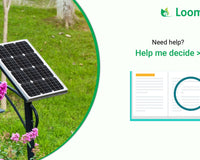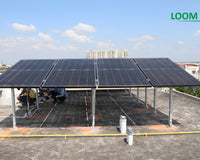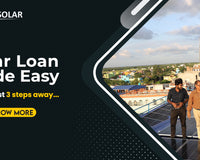Embracing solar system installation is the key to brightening your life while addressing the challenges of high electricity bills and frequent power interruptions. Visualize enhancing your vacant rooftop with glistening rooftop solar panels, converting it into a 24*7 power supply and highly monthly electricity bill saving machine. With the usage of rooftop solar panels your TV, fridge, cooler, fans, lights, computer, internet, AC, water pump, and much more can be run with full capacity without worrying about monthly electricity bills.
Which is the best solar system for your home?
Solar panels are needed when there are electricity problems or high electricity bills. If you live where power cuts happen a lot, you can install an off-grid solar system. And if you live in a place with very little electricity, you can go for an on-grid or hybrid solar system.
1. Off Grid Solar System – An off-grid solar system is a self-contained photovoltaic (PV) energy generation and storage system designed to operate independently of the centralized electrical grid. It typically consists of solar panels, charge controllers, batteries, inverters, and may include backup generators. This system generates, stores, and delivers electricity locally, enabling autonomy from the grid.
2. On Grid Solar System – An on-grid solar system, also known as a grid-tied solar system, is a photovoltaic (PV) power generation setup that connects directly to the utility grid. It efficiently converts sunlight into electricity through solar panels and synchronizes this energy with the grid, allowing for seamless energy exchange and potential net metering, enhancing grid stability, and reducing reliance on non-renewable energy sources.
*(Note – to install the on grid solar system, a permission from the local electricity department is required. As the solar system is directly connected with the power grid.)
3. Hybrid Solar System – A hybrid solar system, in technical terms, integrates photovoltaic (PV) solar panels with an energy storage system and grid connection. This arrangement allows for the simultaneous generation of electricity from solar energy, storage of excess power, and the ability to draw from the grid when needed, optimizing energy production and consumption.
*(Note – to install the hybrid solar system, a permission from the local electricity department is required. As the solar system is directly connected with the power grid.)
What is the price for a solar panel?
The price of a solar panel depends on certain factors such as its kilowatt capacity, number of solar panels, brand, type of technology, etc. To know about the price of a rooftop solar panel visit Loom Solar’s website at https://www.loomsolar.com/collections/solar-panels
How to get solar subsidy or solar loan for your home?
It is important to apply for solar panel subsidy as the national government has certain scheme and subsidies which can provide up to 50,000 rupees or even more in some cases. This amount of solar subsidy can bring down the cost buying a rooftop solar panel / rooftop solar system by a great margin.
To apply for rooftop solar panel subsidy, visit the ‘National Portal for Rooftop Solar’ - https://solarrooftop.gov.in/. For a rooftop solar panel loan, there are multiple banks which provide different types of solar loans for their buyers.
Loom Solar also help its buyers to acquire a solar loan with a hassle free process. To know more about rooftop solar loan visit Loom Solar’s website at https://loan.loomsolar.com/
How many kilowatts of solar system should be installed at a home?
The very basic kilowatt requirement for a solar system is 3 kW. A 3 kW solar system can easily run all the basic to moderate home appliances such as Washing Machine, TV Refrigerator, Fans, Water Geyser, Lights, etc. The process to understand the compatible kilowatt capacity is disrobed below in simple steps-
Step 1: Calculate your loads
Step 2: Know your power cut duration
Step 3: Choose inverter capacity
Step 4: Choose battery type / capacity
Step 5: Choose solar panel type / technology / wattages
For all types of solar systems – On Grid / Off Grid / Hybrid Solar System
Step 1: Calculate your 12 months electricity bills
Step 2: Check your sanctioned load in electricity bill
Step 3: Check your installation areas
Step 4: Get feasibility report for rooftop solar installation
Step 5: Get Solar Quotation from the solar companies
Step 6: Finalize the solar system capacity
Step 7: Apply for solar loan, if you need.
Step 8: Solar Panel Installation by solar installers
Step 9: Apply for Net Meter
Step 10: Apply for Solar Subsidy
Step 11: Get an approval from the local electricity department seeking permission to install on grid and hybrid solar system
*(This step is only applicable for on grid and hybrid solar systems)
Conclusion
In conclusion, solar systems for homes are crucial, because they save money on electricity bills, reduce environmental impact, and provide reliable power source for the next 20 to 25 years. A rooftop solar system can recover the actual cost of the solar system in just 5 years and can provide the ‘ROI’ (Return on Investment) for the next 15 to 20 years of its lifetime.













4 comments
Harry
Seller Fullz, Pros, Leads (USA-UK-CANADA) Tele @ Fullzpros
Looking for Legit Fullz Vendor we got your back
Providing Fresh Database of USA, UK, CANADA & many more
Contact us now at:
Whats App : (+1.. 605.. 846… 1870..)
TG Chanel : t.me/bigdatatrader
Telegram : @ Fullzpros
●ssn/sin/nin dob address phone email
●ssn dob dl address employee & bank info
●sin dob address mmn phone email
●nin dob address sort code & account number
●real dl front back with selfie & ssn, usa passport photos
●you can get specific info {zip|city|state|sex|bank etc}
●ein company pros with & without ssn
Business Owner Leads
Phone Numbers & Email Combos
Mortgage Leads
Crypto & Forex Leads
Stock Market Leads
Cars database with registration number
Home Owner & Bank Leads
Sweepstakes Leads
Payday & Personal Loan Leads
Loan & cashout methods
All 100% Updated Fresh Stuff
Payment upfront in crypto only
Looking for long term business partner
Huge discount offers for bulk buyers
Always checked, Updated & fresh info
For more stuff Hit me at:
Whats App : (+1.. 605.. 846… 1870..)
TG Chanel : t.me/bigdatatrader
Telegram : @ Fullzpros
Email : harrynelson03(at)protonmail.com
Mason Fresco
We can help you solve all HACKING RELATED PROBLEMS
●Hacking of all social media accounts
●Spying on cheating partner
●Retrieving of lost Cryptocurrency
●Data alteration
●Finding of lost phone
●Clearing/paying off of mortgage/loan
●Increasing of credit score
●Bitcoin mining
●Tracking of location
●Hacking of cell phone/other devices
●Block out or track down hackers
Secure yourself now!!!
Contact: cyberhelpdesk88@gmail.com
WhatsApp: +1 (209) 809-0176
Telegram: +1 (209) 809-0176
djdfjfdjgf
The buzz around Titan Edge XL Gummies Reviews has been overwhelmingly positive. Users report noticeable improvements in their energy levels, stamina, and performance. Many reviews highlight the gummies’ ease of use compared to conventional supplements.
https://virmax.omeka.net/
https://forcebeast.omeka.net/
https://prelox.omeka.net/
https://spartan.omeka.net/
https://titanedge.omeka.net/
https://t.co/9oZJoxsJDw
https://t.co/OFUb0lNRVH
https://t.co/xJhcXSopXl
https://t.co/9o30e6cWgq
https://t.co/g7toWR1TAn
https://sites.google.com/view/knox-47-maleenhancement/home
https://www.facebook.com/Knox47MaleEnhancementbuy/
https://www.facebook.com/groups/knox47maleenhancementshop
https://groups.google.com/g/knox47-maleenhancement
https://colab.research.google.com/drive/1T2hOr-XfK51nyvyV2tK-xpK3GzxkHQBY?usp=sharing
https://colab.research.google.com/drive/1kixe5P3c4xdCQnxfoVI00BXM4nYgRzYP?usp=sharing
https://colab.research.google.com/drive/1FTAKYwZrIhQrU5gla3WtAM-2GjCEuSea?usp=sharing
https://knowt.com/note/2e2bf3ae-26f9-4755-81e9-2e81cca5a1dc/Knox-47-Male-Enhancement-Is-Safe-to-Use
https://knowt.com/note/d7b08b33-e427-4c0c-990f-d06894b5dc8b/Knox-47-Male-Enhancement—-Does-it-Work
https://knox47756.omeka.net/
https://knox47dugu.omeka.net/
https://knox47sideeffects.omeka.net/
https://whoherbs.com/ejndurix-cavalor-horse-feed-enhance-horse-performance/
https://whoherbs.com/endurox-prime-male-enhancement-enhance-your-erection-with-satisfaction/
https://whoherbs.com/true-keto-fusion-tired-of-slow-results-results-guaranteed/
https://whoherbs.com/alphastride-male-enhance-fully-loaded-with-stamina-erection/
sgsdgsg
https://www.facebook.com/Ember.Ghee.Male.Enhancement/
https://knowt.com//note/19eb0629-5da0-49aa-a73b-800f375e9970/Ember-Ghee-Male-Enhancement-Mens-Healt
https://knowt.com//note/3f68b784-e585-459d-91d6-2cb0e5a74942/Ember-Ghee-Male-Enhancement-For-ED-Impro
https://knowt.com//note/734b6a20-46f6-450a-bafc-a48b1760ecbb/Ember-Ghee-In-Penis-Enlargement-Does-It
https://knowt.com/note/875be46a-dcb7-46da-b1d4-fa24867335e0/Ember-Ghee-Dietary-Supplement—-Pills-Fo
https://colab.research.google.com/drive/1VdAC1bxjwjPEadVYhEp6T9Hoobk6L36M?usp
https://colab.research.google.com/drive/1vyaYxrY-OGzKEaOKxLSq2WDmNLdFZFNU?usp
https://colab.research.google.com/drive/1XwFrbIj-0wGNIZ7kIqEWME8B5bPcYeXk?usp
https://colab.research.google.com/drive/1AX0og0XMmMlnPpUu5HteHeO7J6-UvAnZ?usp
https://colab.research.google.com/drive/1AQ9As9BEarifyR8ta5qLAwFZ8OFWtJ_2?usp
https://emberghee.omeka.net/
https://emberghee.omeka.net/ember-ghee-for-ed
https://emberghee.omeka.net/ember-ghee-pills
https://emberghee.omeka.net/ember-ghee-male-enhancement
https://emberghee.omeka.net/ember-ghee-reviews
https://colab.research.google.com/drive/1hm3PizoeMgvr2uE0sKlcKzu9OSr7tXaM?usp
https://colab.research.google.com/drive/1a4KIZmBpMsxuUgp36FFtmqW338G0bnOn?usp
https://www.facebook.com/Vitality.Male.Enhancement/
https://www.facebook.com/VirileFlowMaleEnhancement
https://www.facebook.com/Velotal/
https://www.facebook.com/Velotal.Male.Enhancement/
https://doesthephoenixeddevicework.omeka.net/
https://doesthephoenixeddevicework.omeka.net/does-the-phoenix-ed-device-work
https://doesthephoenixeddevicework.omeka.net/the-phoenix-erectile-dysfunction-device
https://thephoenixerectiledysfunctiondevice.omeka.net/
https://thephoenixerectiledysfunctiondevice.omeka.net/the-phoenix-erectile-dysfunction-device
https://thephoenixerectiledysfunctiondevice.omeka.net/does-the-phoenix-ed-device-work
https://knoxformen.omeka.net/
https://knoxformen.omeka.net/knox-47-for-men
https://knoxformen.omeka.net/knox-47-reviews
https://balancenz.omeka.net/
https://balancenz.omeka.net/glyco-balance-new-zealand
http://balanceau.omeka.net/
https://balanceau.omeka.net/glyco-balance-australia
https://lycocare.omeka.net/
https://lycocare.omeka.net/glyco-care
https://www.facebook.com/Endurix.ME/
https://knowt.com//note/7a29e6a2-96c5-41ca-b055-1b1821b40819/Endurix-Male-Enhancement-Uses-Dosage
https://knowt.com//note/963f3411-c688-406d-8691-7afaafbfd1a1/Endurix-For-Men-Male-Enhancement—Is-It-
https://knowt.com//note/2bceeefb-dcb4-4e24-8bdd-08ad09cbf010/Endurix-In-Penis-Enlargement-Does-It-W
https://colab.research.google.com/drive/1H83iPdIWoJQqFIIUFKybGK3KZdSMX1wk?usp
https://colab.research.google.com/drive/1SWXzNWDgnlggrgh9XjHutFZDRBwM7gVF?usp
https://colab.research.google.com/drive/1SWXzNWDgnlggrgh9XjHutFZDRBwM7gVF?forum
https://colab.research.google.com/drive/1JTygnRB32apNyhZXapEdJ3VOqO5nhJ3g?usp
https://endurix.omeka.net/
https://endurix.omeka.net/endurix-pills
https://endurix.omeka.net/male-libido-supplement